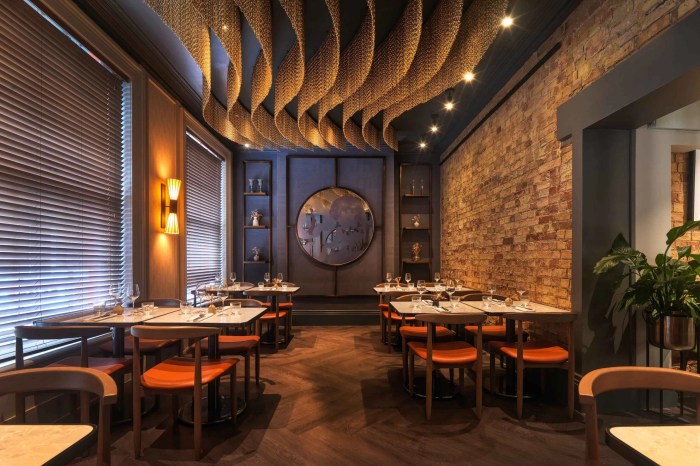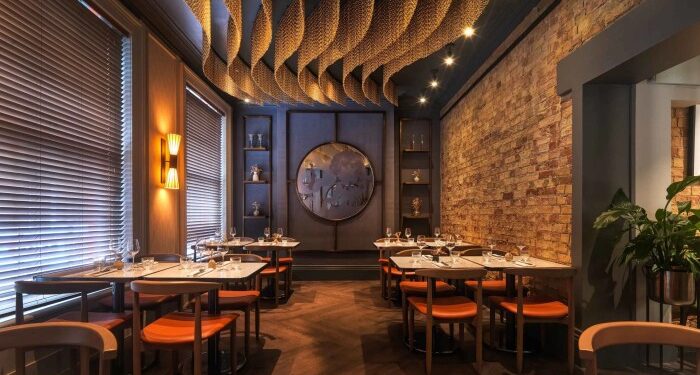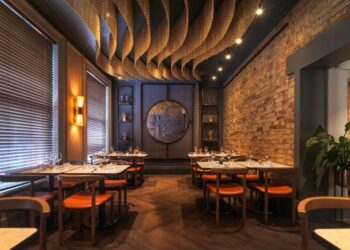Embark on a journey through the world of restaurant interior design, where every element plays a crucial role in shaping the dining experience. From colors to layout, lighting to decor, this topic delves into the art of creating spaces that leave a lasting impression on patrons.
Explore the intricate details that transform ordinary restaurants into extraordinary spaces that captivate all who enter.
Importance of Restaurant Interior Design
Restaurant interior design plays a crucial role in creating a unique and inviting dining atmosphere for customers. It goes beyond just aesthetics, as it can greatly impact the overall dining experience.
Creating Ambiance
The design elements such as lighting, color scheme, furniture, and decor all contribute to setting the ambiance of a restaurant. For example, a cozy and warm interior can make customers feel comfortable and relaxed, while a chic and modern design may attract a younger crowd looking for a trendy dining experience.
Enhancing Brand Identity
Successful restaurants like Nobu, with its sleek and sophisticated Japanese-inspired interiors, and The Ivy, known for its classic and elegant decor, have effectively used interior design to establish and reinforce their brand identities. The design elements reflect the restaurant's concept and cuisine, helping to create a cohesive and memorable dining experience for customers.
Improving Customer Experience
A well-designed restaurant interior can improve the overall customer experience by creating a welcoming and visually appealing space. Customers are more likely to enjoy their meals and return for future visits if they feel comfortable and satisfied with the ambiance and surroundings of the restaurant.
Elements of a Well-Designed Restaurant Interior
Creating a visually appealing restaurant interior involves various key elements that work together to enhance the overall ambiance and experience for diners.
Role of Lighting
- Proper lighting is essential in setting the mood and ambiance of a restaurant.
- Use of natural light can create a warm and inviting atmosphere during the day.
- Dimmer lighting is ideal for evening dining, providing a cozy and intimate setting.
- Accent lighting can highlight specific areas or architectural features, adding depth to the design.
Colors, Textures, and Furniture
- Color scheme should reflect the restaurant's theme and branding, evoking certain emotions in diners.
- Textures like wood, metal, or fabric can add depth and interest to the space, creating a tactile experience for guests.
- Well-chosen furniture that is comfortable and functional is crucial for guest comfort and overall design cohesion.
- Uniformity in design elements like chairs, tables, and decor can create a cohesive and harmonious look throughout the restaurant.
Layout and Space Planning
Effective layout and space planning are crucial aspects of restaurant interior design that can greatly impact the overall success of a dining establishment.An efficient layout is important for maximizing the use of space, ensuring smooth traffic flow, and creating a comfortable dining experience for customers.
It involves strategic placement of tables, seating areas, and service stations to optimize the functionality and aesthetics of the restaurant.Space planning plays a key role in determining how customers and staff move within the restaurant. A well-planned layout can enhance the overall dining experience by providing easy navigation for customers and efficient workflow for staff.
It can also help reduce wait times, improve service quality, and increase customer satisfaction.
Optimizing Space for Different Types of Restaurants
When it comes to different types of restaurants, each requires a tailored approach to space planning to meet the specific needs of their concept and target audience.For fine dining restaurants, space planning should focus on creating an intimate and elegant atmosphere.
This may involve incorporating private dining areas, comfortable seating arrangements, and a sophisticated ambiance to enhance the overall dining experience.Casual dining establishments should prioritize creating a relaxed and inviting space for customers. This can be achieved by designing flexible seating options, communal dining areas, and vibrant decor that reflects the restaurant's brand and concept.Fast food restaurants, on the other hand, need to prioritize efficiency and speed of service.
Space planning should focus on maximizing seating capacity, streamlining the ordering process, and optimizing kitchen layout to ensure quick turnaround times for customers.Overall, the key to successful restaurant interior design lies in understanding the unique requirements of each dining concept and implementing a well-thought-out layout and space plan to enhance the overall dining experience.
Decor and Theme
The decor and theme of a restaurant play a crucial role in creating a unique atmosphere and enhancing the overall dining experience for customers. It sets the tone for the establishment and helps to convey the restaurant's concept and identity.
Reflecting the Restaurant’s Concept
The decor and theme selection should align with the restaurant's concept, cuisine, and target audience. For example, a rustic Italian restaurant may incorporate warm tones, wooden accents, and vineyard-inspired decor to evoke a cozy and authentic dining experience. On the other hand, a modern sushi restaurant may opt for sleek, minimalist decor with a focus on clean lines and subtle Japanese influences.
Influence on Customer Perception and Branding
The decor of a restaurant can significantly impact how customers perceive the establishment and its brand. A well-designed interior that complements the overall concept can leave a lasting impression on diners, enticing them to return and recommend the restaurant to others.
On the contrary, mismatched or poorly executed decor can confuse customers and detract from the dining experience.
Popular Decor Themes
- Industrial Chic: Characterized by exposed brick walls, metal fixtures, and raw materials, this theme is often seen in trendy cafes and urban eateries.
- Coastal Vibes: Incorporating nautical elements, light colors, and natural textures, this theme is popular in seafood restaurants and beachside cafes.
- Vintage Glamour: Featuring retro furnishings, velvet accents, and art deco touches, this theme is often found in upscale cocktail bars and fine dining establishments.
- Farmhouse Charm: Embracing rustic elements, farmhouse tables, and botanical decor, this theme is prevalent in farm-to-table restaurants and cozy brunch spots.
Sustainability and Eco-Friendly Design
In recent years, there has been a growing trend towards sustainable and eco-friendly restaurant interiors. Many restaurant owners are recognizing the importance of reducing their environmental impact and implementing design elements that are both stylish and environmentally conscious.
Incorporating Recycled Materials
One way to achieve sustainability in restaurant interior design is by incorporating recycled materials. This can include using reclaimed wood for tables and chairs, upcycled fixtures, or even repurposed materials for decor elements. By giving new life to old materials, restaurants can reduce waste and create a unique aesthetic.
Energy-Efficient Practices
Another important aspect of eco-friendly design is implementing energy-efficient practices. This can involve using LED lighting, installing smart thermostats, or choosing energy-efficient appliances. By reducing energy consumption, restaurants can lower their carbon footprint and operating costs.
Examples of Environmentally Conscious Restaurants
- Greenhouse Restaurant in Amsterdam: This restaurant features a sustainable interior design with a focus on natural materials and energy-efficient systems. The space is filled with lush greenery, creating a welcoming and eco-friendly atmosphere.
- Noma in Copenhagen: Known for its innovative cuisine, Noma also showcases a commitment to sustainability in its interior design. The restaurant uses recycled and locally sourced materials, as well as energy-saving technologies.
- The Perennial in San Francisco: This restaurant is dedicated to environmental sustainability, from its menu to its design. The interior features reclaimed wood, recycled denim insulation, and a closed-loop water system.
Technology Integration

Technology integration in modern restaurant interiors plays a crucial role in enhancing the overall dining experience for customers and improving operational efficiency for restaurant staff. From digital menus to interactive displays and reservation systems, technology has become an integral part of the restaurant industry.
Digital Menus
Digital menus have revolutionized the way customers order their food. By displaying high-resolution images of dishes, detailed descriptions, and even nutritional information, digital menus help customers make informed decisions. They also allow for easy updates and changes to menu items, prices, and promotions, saving time and resources for the restaurant.
Interactive Displays
Interactive displays, such as touchscreens or tablets at tables, provide customers with entertainment options, ordering capabilities, and even feedback forms. These displays not only engage customers but also streamline the ordering process, reduce wait times, and improve accuracy in food preparation.
Reservation Systems
Online reservation systems have made it convenient for customers to book tables in advance, reducing wait times and ensuring a seamless dining experience. These systems also help restaurants manage their seating capacity, track customer preferences, and optimize table turnover, leading to increased efficiency and revenue.
Impact on Customer Engagement and Operational Efficiency
The integration of technology in restaurant interiors has significantly enhanced customer engagement by providing personalized experiences, interactive features, and efficient service. It has also improved operational efficiency by automating processes, reducing errors, and optimizing resource utilization. Overall, technology integration has transformed the way restaurants operate and interact with their customers in the digital age.
Final Review
As we conclude our exploration of restaurant interior design, we reflect on the importance of thoughtful design choices that elevate the dining experience. From sustainable practices to innovative technology integration, the possibilities for creating unforgettable spaces are endless.
Clarifying Questions
How does lighting impact the ambiance of a restaurant?
Lighting can set the mood in a restaurant, influencing how customers feel and perceive the space. Soft, warm lighting can create a cozy atmosphere, while bright lights may convey a more energetic vibe.
What are some popular decor themes in fine dining establishments?
Fine dining restaurants often opt for elegant decor themes such as modern luxury, classic sophistication, or themed designs inspired by cultural influences.
Why is sustainability important in restaurant interior design?
Sustainability helps reduce the environmental impact of restaurants and showcases a commitment to ethical practices, attracting eco-conscious customers.














